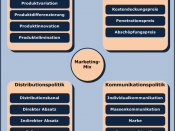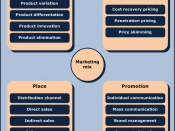"Marketing is the anticipation and identification of the customers wants and needs and the meeting of them in order to make a profit."� The marketing process A firm will gather information about the marketplace (e.g. whether house prices are rising or falling), and then research consumers' needs. From this, it will identify who its market is, and then put together a marketing plan based on the findings. The marketing mix will be central to this, and finding the right balance in each of the 4Ps is very important. The firm can then review and adapt their plan when they need to. You should remember the following points: Although marketing is consumer-orientated, the main aim is still to be profitable.
A good marketing manager will try to differentiate their product (i.e. make their product stand out against similar competitive zoo's).
Whatever pricing decision is made, the most important factor is to break even.
For marketing to efficient it must incorporate the 4 P's, product, price, promotion and place.
Product is the service that Chester zoo offers. It must have the right features.
Promotion is how does Chester zoo make the customer aware and want their service/product. This may be achieved by advertising via sponsored events etc. successful promotion helps a firm to spread costs over a larger output.
Place is the situation of the zoo, this must be suitable for their market by having a large empty area for the animals (not by any busy roads etc) and be easily excisable to its customers. Customers must be willing to travel to the zoo; it's this area in which people are will to travel to the zoo is the zoo's shear of influence. The shear of influence effects the type of promotion used.
Price is the type of pricing statuary used.
Pricing strategies "" Product orientated- Is when a product is made/developed by producer. Thinking it will sell (no market research). A good example of this is Clive Sinclere's pocket calculator, he created it with out asking the consumer if they wanted it but it was a big hit.
Market orientated- They do market research and find out what customer wants.
The research process - Marketing departments need to have information so they can get their marketing mix right. For example, they will want to know what similar products already exist and how much they cost. They will also want to know whether consumers will want to buy their new product, and what they think about it. The process for doing this is as follows: 1. Identify a problem 2. Set objectives 3. Gather data 4. Analyse data Now have a look at the process in more detail. If you were a marketing manager, you might do the following things: Identify the problem Make sure you know what you are trying to find out, and how it will help you. This is something that people sometimes forget. There is an endless amount of information available, so it is important to be focused.
Set objectives You have to decide which are going to be the best ways to gather this information. Choose the most appropriate reports and journals. Depending on how much time you have, choose what field research you can do. Designing questionnaires and testing products on consumers can take a long time. You also have to decide whether you have the necessary skills, or whether you need to use a specialist research organisation. This is a more expensive option.
Gather data You would usually do desk research first, because it is cheaper and quicker. Then supplement this with field research, so that you don't duplicate your findings. Designing the questionnaires and conducting the surveys takes place during this phase.
Analyse data Now that you have the findings, you have to work out what they are telling you. If you identified your objectives before you started, this should not be too difficult. You must look for trends and patterns. Then you should see how this affects your marketing mix. For example, if you were thinking of setting a price for your product of ÃÂã10 per unit, and 70% of the sample group think this is too high, then you may need to consider reducing the price. If you don't, you may find that few consumers will buy it. But remember: no survey is perfect. There is always a margin of error.
The advantages for Chester zoo are "" You know your market Increase your sales You get competitive edge Economics of scale Encourage new customers You gain customer loyalty Price discrimination.
Product discrimination.


